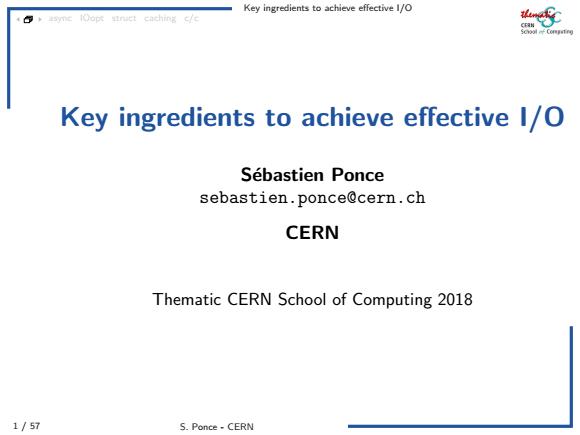
Key ingredients to achieve effective 1/O 4 asycop nct caching c/e Key ingredients to achieve effective l/O Sebastien Ponce sebastien.ponce@cern.ch CERN Thematic CERN School of Computing 2018 1/57 S.Ponce-CERN
Key ingredients to achieve effective I/O 1 / 57 S. Ponce - CERN async IOopt struct caching c/c Key ingredients to achieve effective I/O S´ebastien Ponce sebastien.ponce@cern.ch CERN Thematic CERN School of Computing 2018
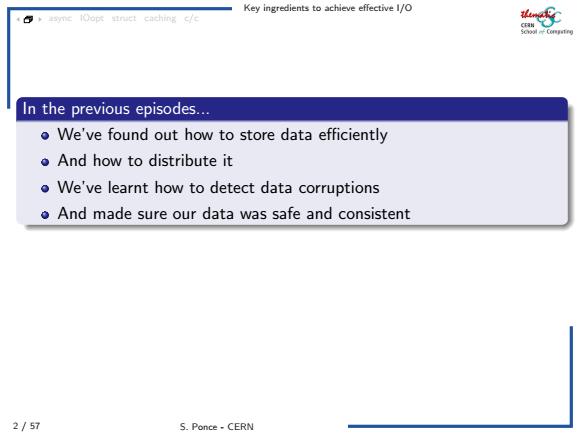
Key ingredients to achieve effective 1/O 4,yme0op时nct caching c/c In the previous episodes... o We've found out how to store data efficiently o And how to distribute it o We've learnt how to detect data corruptions o And made sure our data was safe and consistent 2/57 S.Ponce-CERN
Key ingredients to achieve effective I/O 2 / 57 S. Ponce - CERN async IOopt struct caching c/c In the previous episodes... We’ve found out how to store data efficiently And how to distribute it We’ve learnt how to detect data corruptions And made sure our data was safe and consistent Today How do we use them ? Efficiently
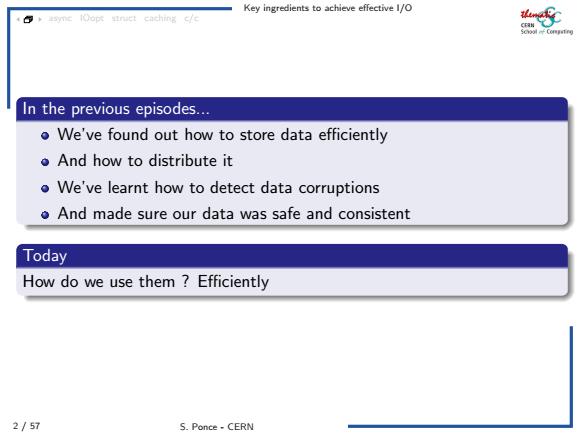
Key ingredients to achieve effective 1/O syme 0opt snict caching c/e “ In the previous episodes... o We've found out how to store data efficiently o And how to distribute it o We've learnt how to detect data corruptions o And made sure our data was safe and consistent Today How do we use them Efficiently 2/57 S.Ponce-CERN
Key ingredients to achieve effective I/O 2 / 57 S. Ponce - CERN async IOopt struct caching c/c In the previous episodes... We’ve found out how to store data efficiently And how to distribute it We’ve learnt how to detect data corruptions And made sure our data was safe and consistent Today How do we use them ? Efficiently

Key ingredients to achieve effective 1/O ye I(op nct caching c/e Outline ① Asynchronous 1/O Latency Asynchronous l/O interfaces ●Message queues 2 I/O optimizations Optimizing network transfers Optimizing local transfers Influence of data structures on I/O o Measuring I/O efficiency of algorithms Caching o Principles Policies ●Distributed Caches 3 Conclusion 3/57 S.Ponce-CERN
Key ingredients to achieve effective I/O 3 / 57 S. Ponce - CERN async IOopt struct caching c/c Outline 1 Asynchronous I/O Latency Asynchronous I/O interfaces Message queues 2 I/O optimizations Optimizing network transfers Optimizing local transfers 3 Influence of data structures on I/O Measuring I/O efficiency of algorithms 4 Caching Principles Policies Distributed Caches 5 Conclusion
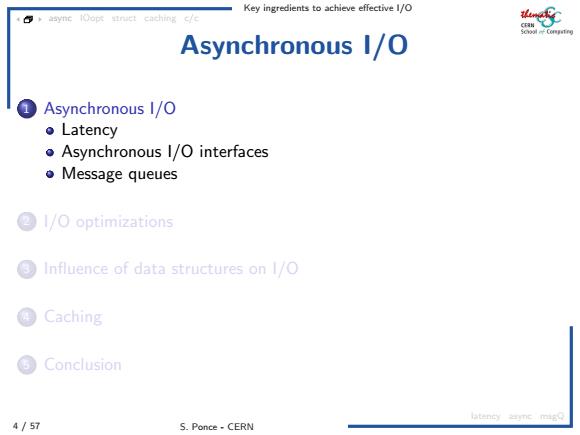
Key ingredients to achieve effective 1/O 4心async0op时anet caching c/e Asynchronous 1/O ①Asynchronous I/O Latency Asynchronous l/O interfaces ·Message queues ②l/0 optimizations Influence of data structures on 1/O Caching Conclusion tancy ac mi名 4/57 S.Ponce-CERN
Key ingredients to achieve effective I/O 4 / 57 S. Ponce - CERN async IOopt struct caching c/c latency async msgQ Asynchronous I/O 1 Asynchronous I/O Latency Asynchronous I/O interfaces Message queues 2 I/O optimizations 3 Influence of data structures on I/O 4 Caching 5 Conclusion

Key ingredients to achieve effective 1/O asyne l0op nact cachincc 花5 Sources of I/O latency Physical constraints preparing an SSD(~100 us) omoving disk's arm (~10ms) omounting and rotating tapes(1 min) latency amc mig 5/57 S.Ponce-CERN
Key ingredients to achieve effective I/O 5 / 57 S. Ponce - CERN async IOopt struct caching c/c latency async msgQ Sources of I/O latency Physical constraints preparing an SSD (∼ 100 ➭s) moving disk’s arm (∼ 10 ms) mounting and rotating tapes (∼ 1 min) Network infrastructure number of switches routers on the way 200 ➭s delay per switch/router “slow” speed of light “speed” of light is slower in a fiber (refractive index 1.47) that gives around 200 m ➭s −1 or 20 cm ns −1 Budapest’s ping time from CERN is ∼21 ms for ∼2500 km

Key ingredients to achieve effective 1/O caching c/c Sources of 1/O latency Physical constraints preparing an SSD(~100 us) omoving disk's arm (~10ms) o mounting and rotating tapes(1 min) Network infrastructure o number of switches routers on the way o 200 us delay per switch/router latency ac mig 5/57 S.Ponce-CERN
Key ingredients to achieve effective I/O 5 / 57 S. Ponce - CERN async IOopt struct caching c/c latency async msgQ Sources of I/O latency Physical constraints preparing an SSD (∼ 100 ➭s) moving disk’s arm (∼ 10 ms) mounting and rotating tapes (∼ 1 min) Network infrastructure number of switches routers on the way 200 ➭s delay per switch/router “slow” speed of light “speed” of light is slower in a fiber (refractive index 1.47) that gives around 200 m ➭s −1 or 20 cm ns −1 Budapest’s ping time from CERN is ∼21 ms for ∼2500 km

Key ingredients to achieve effective 1/O asyncOop4nut caching c/c Sources of I/O latency Physical constraints preparing an SSD(~100 us) moving disk's arm (10ms) o mounting and rotating tapes(~1 min) Network infrastructure o number of switches routers on the way 200 us delay per switch/router "slow"speed of light "speed"of light is slower in a fiber(refractive index 1.47) ·that gives around200mμs-1or20cmns-1 o Budapest's ping time from CERN is ~21ms for ~2500km latency ac mig 5/57 S.Ponce-CERN
Key ingredients to achieve effective I/O 5 / 57 S. Ponce - CERN async IOopt struct caching c/c latency async msgQ Sources of I/O latency Physical constraints preparing an SSD (∼ 100 ➭s) moving disk’s arm (∼ 10 ms) mounting and rotating tapes (∼ 1 min) Network infrastructure number of switches routers on the way 200 ➭s delay per switch/router “slow” speed of light “speed” of light is slower in a fiber (refractive index 1.47) that gives around 200 m ➭s −1 or 20 cm ns−1 Budapest’s ping time from CERN is ∼21 ms for ∼2500 km

Key ingredients to achieve effective 1/O asyne l0op nact cachinc Impact of I/O latency Typical I/O pattern Source Destination time latency ac mg 6/57 S.Ponce-CERN
Key ingredients to achieve effective I/O 6 / 57 S. Ponce - CERN async IOopt struct caching c/c latency async msgQ Impact of I/O latency Typical I/O pattern send a packet to destination wait for ack go to next block Source Destination time sending time efficiency = sending time sending time + ping time
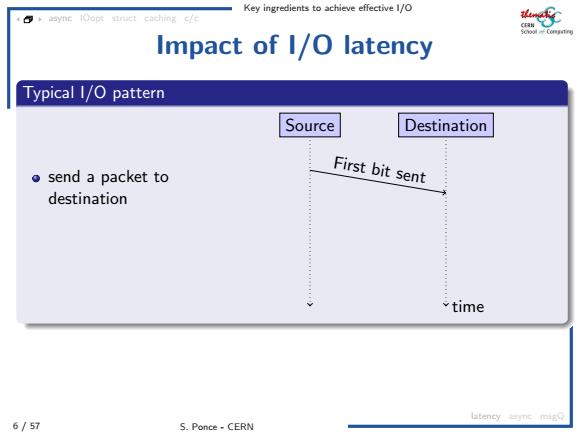
Key ingredients to achieve effective 1/O asyne l0op nact cachinc Impact of I/O latency Typical I/O pattern Source Destination ●send a packet to First bit sent destination time 6/57 latency c mig S.Ponce-CERN
Key ingredients to achieve effective I/O 6 / 57 S. Ponce - CERN async IOopt struct caching c/c latency async msgQ Impact of I/O latency Typical I/O pattern send a packet to destination wait for ack go to next block Source Destination time First bit sent sending time efficiency = sending time sending time + ping time